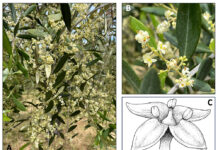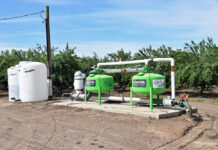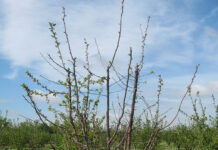
It is a mistake to let an alfalfa field ‘limp along’ on inadequate irrigation throughout the growing season, letting yields and quality suffer. The better strategy for hay production, according to UCCE Specialist Dan Putnam, is to fill the soil profile early and get as much yield as possible and then allow the stand to go dormant.
“It is a resilient crop. It can come back within the fall when it receives some moisture,” Putnam said.
Filling the soil profile early will give growers the two to three cuttings that are usually higher in yields and quality than those later in the season.
Alfalfa growers throughout the state can develop strategies to keep good alfalfa stands productive in drought conditions. Putnam said the first step is to decide which fields or parts of fields will benefit the most from what irrigation water is available. Those should have priority. Alfalfa stands nearing the end of their productive life, those on soils that do not hold moisture well or spotty stands are best left to go dormant to direct water to alfalfa stands that will benefit the most.
Ending irrigation in mid- to late summer for alfalfa fields will not end their productive life. The stands will turn brown and go dormant, but generally won’t be lost. Depending on the soil type, Putnam said, most of the time alfalfa will recover with fall rains or irrigation. Putnam pointed out that 60% to 65% of annual alfalfa yields in most parts of California are achieved by mid-July.
Putnam wrote in a UC publication that alfalfa has a key role in California’s water-uncertain future due to its high flexibility during times of insufficient and excess water. Alfalfa’s deep roots tap into residual soil moisture. Multiple harvests can give partial economic yields when irrigation ceases. Alfalfa roots survive summer dry-downs and will come back when re-watered. Alfalfa fields can be flooded in winter to recharge aquifers. The crop also has high salinity tolerance.
Alfalfa has proved to be highly flexible and resilient in surviving droughts while sustaining productivity, even when as little as half the water requirement is applied, Putnam said. The resilience of alfalfa was demonstrated during the 2021 drought in the Tulelake area where a full yield of two cuttings of alfalfa was observed with zero irrigations. Only six inches of rainfall occurred before March. Alfalfa roots were deeper than eight feet. The soils there have excellent water holding capacity, Putnam said, but the production showed the resiliency of alfalfa with limited water supply.
Further discussion of strategies for drought conditions can be seen at a blog on drought at https://ucanr.edu/blogs/Alfalfa/.















